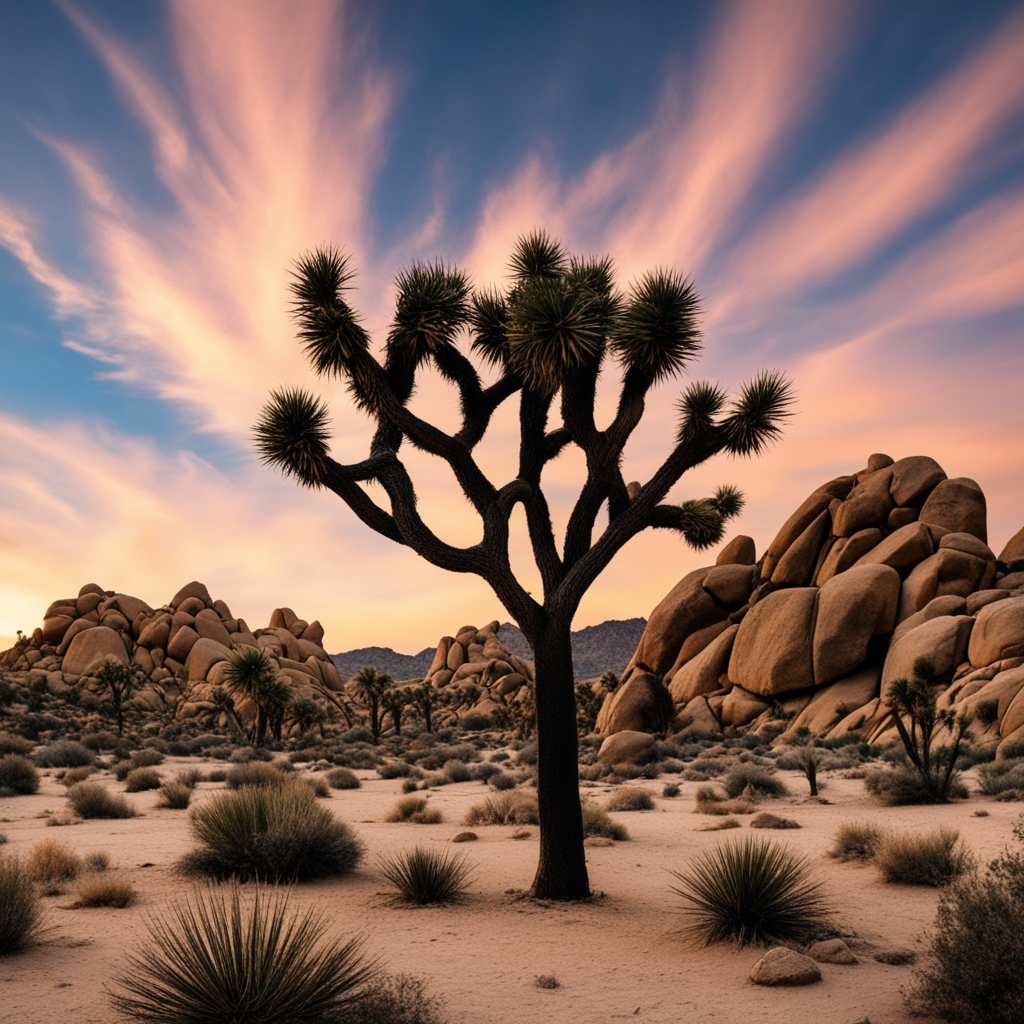Exploring Joshua Tree National Park: A Guide to Nature’s Oasis with 7 Must-See Landmarks
Introduction
🌵 Welcome to the mystical allure of Joshua Tree National Park, where the sun-kissed desert landscape dances with ancient rock formations and vibrant flora! If you’re craving an escape to nature’s masterpiece, you’re in for a treat. This blog is your passport to an adventure-filled journey through the heart of this Californian gem, where every step unveils a new story and every sunset paints the sky in hues you never knew existed.
Picture this: towering Joshua Trees standing like sentinels, unique rock formations carved by centuries of wind and water, and a night sky so clear it’s like a celestial canvas splashed with stars. In this corner of the Mojave Desert, magic and tranquility converge, inviting you to explore its hidden wonders.
But hold on, we’re not just here to talk about the ordinary. Get ready for insider tips, eco-friendly adventures, and a curated list of seven must-see landmarks that will leave you awe-inspired. Whether you’re an avid hiker, a stargazer, or simply someone yearning for a rejuvenating getaway, Joshua Tree National Park has something special for everyone.
So, grab your hiking boots, pack some snacks, and join us on a virtual journey into the heart of Joshua Tree. Let’s uncover the secrets of this desert oasis together – adventure awaits! 🏜️✨
| # | Attraction | What’s Special |
|---|---|---|
| 1 | Joshua Tree Wonderland | Iconic Joshua Trees creating a unique desert landscape. |
| 2 | Keys View | Panoramic viewpoint offering breathtaking desert vistas. |
| 3 | Skull Rock | Natural rock formation resembling a skull. |
| 4 | Barker Dam | Historic dam surrounded by desert wildlife and flora. |
| 5 | Cholla Cactus Garden | Mesmerizing landscape filled with cholla cacti. |
| 6 | Arch Rock | Natural arch formation perfect for photo opportunities. |
| 7 | Hidden Valley | Secluded valley with unique rock formations. |
| 8 | Lost Horse Mine | Historical gold mine with scenic desert views. |
| 9 | Ryan Mountain | Challenging hike with panoramic views at the summit. |
| 10 | Cap Rock | Natural rock formation and popular rock climbing spot. |
| 11 | Cottonwood Spring | Oasis with hiking trails and desert vegetation. |
| 12 | Jumbo Rocks | Maze of massive rock formations for exploration. |
| 13 | Indian Cove | Campground surrounded by unique rock formations. |
| 14 | Live Oak Picnic Area | Shaded picnic spot with desert vegetation. |
| 15 | Belle Campground | Quiet campground with stunning night skies. |
| 16 | Warren Peak | Hike to a high point with expansive desert views. |
| 17 | Rattlesnake Canyon | Slot canyon with unique rock formations. |
| 18 | Desert Queen Mine | Historical mine site with remnants of the past. |
| 19 | Boy Scout Trail | Scenic trail with diverse desert landscapes. |
| 20 | Split Rock | Large boulder split in half, surrounded by desert beauty. |
| 21 | Black Rock Canyon | Joshua Tree forest and hiking trails. |
| 22 | Lost Palms Oasis | Hidden oasis in the desert with palm trees. |
| 23 | Wonderland of Rocks | Labyrinth of rock formations for exploration. |
| 24 | Covington Flats | Expansive flat area with panoramic desert views. |
| 25 | Mastodon Peak | Hike to a peak with views of the surrounding landscape. |

About Joshua Tree Park:
Joshua Tree National Park?
Joshua Tree National Park is a captivating desert haven celebrated for its iconic Joshua Trees and distinct rock formations.
Where is Joshua Tree National Park?
Nestled in southeastern California, the park sprawls across the Mojave and Colorado Deserts.
History of Joshua Tree National Park?
Established in 1994, the park holds a fascinating history, with ancient Native American influences and a unique desert ecosystem.
Interesting facts about Joshua Tree National Park?
Home to the Joshua Tree, named by Mormon pioneers who saw the tree’s branches resembling Joshua reaching out in prayer.
What to do in Joshua Tree National Park?
Engage in diverse activities, including hiking, rock climbing, stargazing, and immersing in the unique desert flora and fauna.
Accommodation:
Hotels near Joshua Tree National Park?
Discover a range of accommodations, from cozy inns to luxury resorts, providing comfortable stays near the park.
Lodging near Joshua Tree National Park?
Explore various lodging options, including campsites, cabins, and hotels, catering to different preferences.
Airbnb Joshua Tree National Park?
Opt for unique Airbnb rentals for an immersive experience, from charming desert cottages to stylish retreats.
Resorts near Joshua Tree National Park?
Indulge in luxury resorts offering amenities and stunning views, making your stay near the park memorable.
Motels near Joshua Tree National Park?
Convenient and budget-friendly, motels around the park provide a comfortable base for exploration.
Camping Joshua Tree National Park?
Immerse in nature by camping in designated areas, enjoying the serene desert landscapes and starry nights.
Cabins in Joshua Tree National Park?
Experience a rustic getaway in charming cabins nestled in the desert, offering a unique stay close to nature.
Activities and Things to Do:
Joshua Tree National Park things to do?
Embark on a variety of activities, including hiking, rock climbing, stargazing, and wildlife observation.
Joshua Tree National Park activities?
Engage in ranger-led programs, birdwatching, and photography, adding depth to your park experience.
Joshua Tree National Park trails?
Traverse scenic trails like the Hidden Valley Trail or Barker Dam Trail, each offering a unique desert adventure.
Best hikes in Joshua Tree National Park?
Explore renowned hikes like Ryan Mountain or the Lost Horse Mine Trail for breathtaking desert vistas.
Joshua Tree National Park stargazing?
Revel in the celestial wonders at dedicated stargazing spots, capturing the brilliance of the night sky.
Glamping in Joshua Tree National Park?
Experience luxury camping in the desert, combining comfort and nature for a unique glamping adventure.

Weather and Hours:
Joshua Tree National Park weather?
Expect a desert climate with hot days and cool nights; check forecasts for the best time to visit.
Weather in Joshua Tree National Park 10 days?
Monitor extended forecasts to plan your trip, considering temperature variations and potential weather changes.
Joshua Tree National Park hours?
Be aware of park hours, typically from sunrise to sunset; check for any seasonal variations.
What time does Joshua Tree National Park open?
Parks usually open at sunrise, offering early birds the chance to experience the serene mornings.
Fees and Entrance:
Joshua Tree National Park entrance?
Access the park through designated entrances; check for fees, which contribute to conservation efforts.
Joshua Tree National Park entrance fee?
Be aware of the entrance fee, supporting the park’s maintenance and preservation initiatives.
Joshua Tree National Park fees?
Familiarize yourself with park fees, varying for different activities and types of visitors.
Joshua Tree National Park ticket?
Purchase tickets at the entrance or online; consider annual passes for multiple visits.
Wildlife and Nature:
Joshua Tree National Park animals?
Encounter diverse wildlife, including bighorn sheep, desert tortoises, and a variety of bird species.
Joshua Tree National Park wildlife?
Embrace the opportunity to spot unique desert fauna; bring binoculars for a closer look.
Joshua Tree National Park biodiversity?
Marvel at the park’s biodiversity, showcasing an array of plant and animal life adapted to the desert environment.
Joshua Tree National Park elevation?
The elevation of Joshua Tree National Park varies, ranging from 536 feet (163 m) in the park’s far southeast corner to the summit of Quail Mountain, which stands at 5,814 feet (1,773 m).
Wildlife and Nature:
Delve into the rich biodiversity of Joshua Tree National Park. Encounter a diverse array of wildlife, from elusive desert tortoises to majestic bighorn sheep. Explore the intricacies of the desert flora, adapted to thrive in this unique environment. The park’s elevation, ranging from 536 feet to the summit of Quail Mountain at 5,814 feet, provides varied landscapes, each with its own distinct charm. Capture the essence of the desert’s living wonders through your binoculars and camera lens as you connect with nature in this captivating desert sanctuary.
Photography:
Bring your photography skills to life in Joshua Tree National Park. The surreal landscapes, characterized by twisted Joshua Trees and captivating rock formations, offer an ideal canvas for both amateur and professional photographers. Capture the vibrant hues of a desert sunset, play with shadows and light on the unique geological features, and immortalize the diverse flora and fauna that call this arid landscape home. Don’t forget to share your photographic journey, contributing to the visual tapestry that showcases the park’s timeless beauty.
Seasonal Considerations:
Timing is everything when it comes to experiencing Joshua Tree National Park. Plan your visit during the fall or spring for milder temperatures, blooming wildflowers, and comfortable outdoor activities. These seasons provide an ideal backdrop for hiking, rock climbing, and enjoying the park’s natural wonders. If you’re seeking a unique desert experience, consider a winter visit when cooler temperatures add a refreshing touch to the arid landscape, and the night sky becomes a canvas of celestial wonders. Explore the park’s diverse offerings based on the season, ensuring a memorable and tailored experience.


